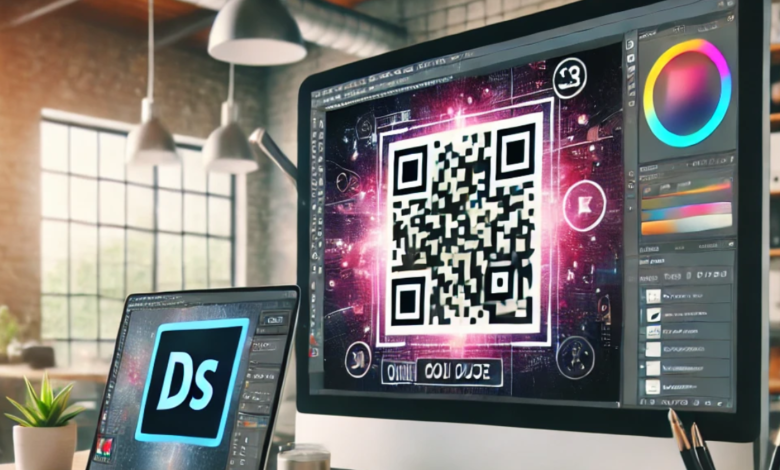QR Code Generator Adobe: The Ultimate Guide to Creating QR Codes with Adobe Tools

Introduction to QR Codes and Their Importance
QR codes have become an integral part of modern digital interactions. Whether you’re marketing a business, sharing contact information, or directing users to a website, QR codes offer a seamless way to connect digital and physical experiences. With the rise of smartphones, scanning QR codes is easier than ever, making them a powerful tool for businesses, educators, and personal use.
Adobe, known for its cutting-edge creative tools, provides multiple ways to create high-quality, customized QR codes. Unlike free online generators, Adobe’s solutions allow for design flexibility, branding, and higher resolution output, making them ideal for professional and commercial use.
Why Use Adobe for QR Code Generation?
In this guide, we’ll explore different tools you can use to generate QR codes, how to customize them, and best practices to ensure your QR codes are scannable and effective.
1. High-Quality Output
Unlike many free QR code generators that produce low-resolution images, tools allow you to create vector-based QR codes. This means they can be resized without losing clarity, making them ideal for print and digital applications.
2. Customization Options
Adobe software provides endless customization options, from adjusting colors to embedding logos. This is essential for businesses that want QR codes that align with their branding.
3. Integration with Adobe Creative Suite
If you’re already using Adobe Illustrator, Photoshop, or InDesign, generating QR codes within these tools simplifies the design workflow. No need for external generators—everything stays within your project.
4. Professional-Grade Designs
tools allow you to create QR codes that don’t just work but also look visually appealing. A well-designed QR code can enhance brand identity rather than looking like an afterthought.
Methods to Generate QR Codes Using Tools
Adobe provides multiple ways to generate QR codes, depending on your needs. Let’s explore the best tools for the job:
1. Adobe Illustrator: The Best Tool for Custom QR Codes
Adobe Illustrator is one of the best tools for creating and customizing QR codes. It provides vector-based designs, allowing for unlimited scalability and customization.
How to Create a QR Code in Illustrator:
- Use a Third-Party QR Code Generator – Adobe Illustrator itself does not have a built-in QR code generator, so you’ll need to generate a basic QR code from an online tool such as QR Code Monkey or Adobe Express.
- Import the QR Code into Illustrator – Open Illustrator and place the downloaded QR code image.
- Convert to Vector – Use Image Trace to convert the QR code into a vector graphic. Adjust settings for optimal sharpness.
- Customize the Design – Change colors, add a logo, or incorporate the QR code into a unique design while ensuring scannability.
- Export in High Quality – Save your QR code in EPS, SVG, or PDF format for professional use.
Illustrator is the best choice for businesses looking to integrate QR codes into branding materials without compromising aesthetics.
2. Adobe InDesign: The Most Efficient Way to Create QR Codes
If you’re looking for a built-in solution, Adobe InDesign is the way to go. InDesign allows you to generate and customize QR codes directly within the software.
Steps to Create a QR Code in Adobe InDesign:
- Open Adobe InDesign and Create a New Document – Set the page dimensions according to your needs.
- Go to Object > Generate QR Code – This opens a QR code generator within InDesign.
- Enter Your Data – You can input a URL, text, email, phone number, or even an SMS message.
- Adjust the Settings – Customize the color and background, ensuring contrast for easy scanning.
- Place the QR Code – Click “OK” and position the QR code in your document.
- Export the Final Design – Save as PDF or print directly from InDesign.
This method is perfect for designers working on print materials such as business cards, flyers, or brochures where QR codes need to be seamlessly integrated.
3. Adobe Photoshop: Adding QR Codes to Designs
While Photoshop isn’t the best tool for creating QR codes from scratch, it’s useful for integrating and enhancing QR codes within digital and print designs.
Steps to Work with QR Codes in Photoshop:
- Generate a QR Code Using Adobe Express or a Free Online Generator – Download it in high resolution.
- Open Photoshop and Import the QR Code – Place the image in your design file.
- Enhance with Effects – Use layer styles, shadows, and color overlays to make it stand out while keeping it readable.
- Save in the Desired Format – Export in PNG, JPEG, or PDF depending on your use case.
Best Practices for Creating QR Codes with Adobe Tools
This method is great for creating promotional images or adding QR codes to social media graphics.
1. Ensure High Contrast
A QR code should always have sufficient contrast between the background and foreground. Black on white is the safest choice, but if branding requires colors, ensure they provide enough contrast.
2. Test Before Publishing
Always scan your QR code before finalizing the design. Use multiple devices to ensure compatibility.
3. Avoid Overcomplicating the Design
While customization is great, excessive design elements can reduce scan accuracy. Keep QR codes simple and functional.
4. Choose the Right Format
For web use, PNG or SVG is best. For print, always opt for vector formats like EPS or PDF to maintain sharpness at any size.
5. Provide a Backup URL
If your QR code is directing users to a website, include a written URL as a backup in case scanning fails.
Conclusion: Which Adobe Tool Should You Use?
- Adobe Illustrator – Best for fully customizable, high-resolution QR codes that match your brand.
- Adobe InDesign – Best for quickly generating QR codes for print materials.
- Adobe Photoshop – Best for integrating QR codes into marketing materials and digital designs.
If you’re looking for the easiest way to generate QR codes directly within Adobe, InDesign is the winner. However, if you need branding flexibility, Illustrator is unmatched. Photoshop is excellent for incorporating existing QR codes into larger projects.
Regardless of your choice, Adobe’s powerful design tools give you the ability to create professional, high-quality QR codes that enhance your marketing and business efforts.
So, the next time you need a QR code, ditch the free online generators and leverage the power of Adobe for the best results!





